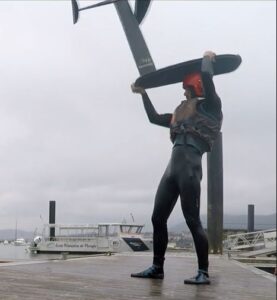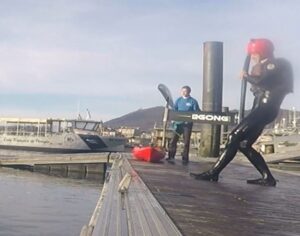I consider the beach start to be the most difficult start with foil, so before learning it I recommend learning the other starts that I have in the tutorial. Above all, it is essential to learn the dead start since in my opinion they are very similar. In the beach start you have the advantage of getting a bit of a run-up and in the dead start the advantage of being higher up, but the key movement of the hands on the board and explosiveness are exactly the same.
You can do beach start from almost any beach with experience and the right foil but to start it is better to first find the ideal spot. You cannot learn if your head is distracted by the waves, or you are afraid of hitting the bottom and damaging the foil or hurting yourself.
- Sand or dirt bottom. In the first attempts you will hit the bottom with the foil many times, so choose a bottom with sand or dirt without stones.
- Firm bottom. Some beaches have sand that sinks a lot, or if it is dirt it can be too clayey and prevents you from running agilely, so if your foot sinks a lot it will not be suitable.
- Fast depth. The section you are going to ride should be shallow, up to below the knee for agile running and jumping, but then it should go down quickly so you don’t have to worry about hitting the bottom.
- Better without waves. When you are learning you have enough things to think about without worrying about waves, so try to find a lake or a beach without waves. If you have no choice but to do it with waves it is a little easier if the wave is entering the beach rather than returning.
Material:
- Use the shortest mast you have and with which you are able to pump so that jumping on the board is easier. In my case I learned with a 70cm one, try to have yours between 65 and 75cm.
- You need a foil that plans a lot, a large low aspect or if not a high aspect with a lot of glide.
- The thinner and narrower the board, the better.
Steps to follow:
- To start, place your back foot out of the water, the stabilizer out of the water, and the front wing just touching the water and touching the front foot in front. Unless the shallow end is long, then you should start further in.
- Your hands on the sides of the board at about the same height as you put them for the deadstart.
- As in the dead start, push the board forward and at the same time place your hands on the board and press only with the back hand throughout the race, the front hand only guides without hardly any support, to keep the foil close to the surface. If the board sinks when you run, it means that you are supporting your front hand too much or that you should move your back hand back.
- Take a step with your back foot and another with the front foot, and when the front foot touches the ground, you have to push yourself onto the board, SUPPORTING ONLY THE REAR HAND and pushing the board forward as in the deadstart. Some recommend lifting the back foot first and then the front foot, but in my case it is easier to do it in one go.
- The hand positioning has to be very fast like in a dead start, and the two explosive steps. You can also do it in 4 steps, but I do better in 2. The more I run, the more explosiveness I lose and the more chances I have of losing concentration on a step on the sand or ending up with my legs too deep in the water. If you can do a dead start without any steps, you can do a beachstart with 2 steps.
Now it’s time to practice and practice this to build muscle memory because when you go to a beach with waves, with a non-perfect depth, or with rocks on the bottom, your head will be somewhere else and even though it may not seem that it becomes much more difficult.



